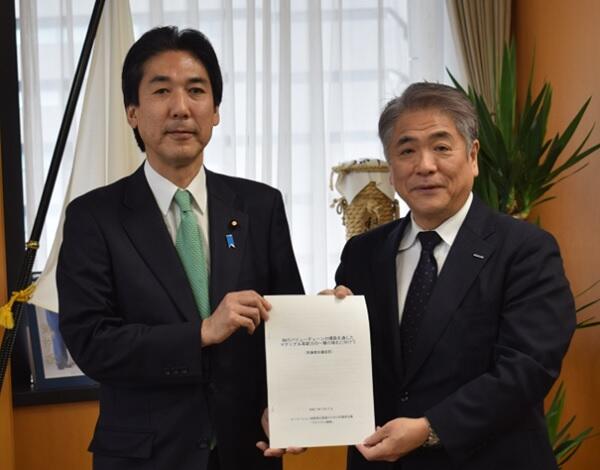To continue winning in the materials field, Japan must build a "knowledge value chain" that involves industry, academia, and government to continuously create innovation leading to economic growth. The Cabinet Office's Materials Strategy Experts Meeting (chaired by Hideyuki Yamagishi, Primary Executive Officer of Asahi Kasei) compiled recommendations and presented them to Minoru Kiuchi, Minister of Science and Technology Policy. Kiuchi stated, "The Materials Innovation Strategy was formulated four years ago, but since then, the global situation has changed significantly. Based on the recognition that materials are the core driving innovation in quantum technology, AI, semiconductors, and more, we would like to revise our materials strategy based on these recommendations and actively advance it as a government."
The expert committee has been discussing future measures while confirming the progress of the materials strategy since last October. Yamagishi said, "Given the increasing importance of materials, we have compiled these recommendations as guidelines for industry, academia, and the government to join forces."

The recommendations emphasize the importance of Japan continuing to succeed in the materials field by creating a virtuous cycle of continuous innovation through knowledge transfer, bringing together the strengths of diverse players with excellent technical capabilities, one of the country's fortes.
So, in which areas should Japan continue to focus? The recommendations specify fields to focus on in the short to medium term: (1) high-performance, high-value-added materials where Japan currently holds technical superiority, (2) materials key to resource security/circulation and supply chain resilience through circular economy, (3) green and energy-related materials for achieving GX (green transformation), (4) materials important for economic security (semiconductors, etc.), and (5) innovative manufacturing technologies combining advanced material design, evaluation, and analysis (including advanced mass production technologies).
For the medium to long term (frontier challenges), the recommendations highlight: (1) value frontiers—challenges in new areas identified through back casting from social issues and forecasting from technological starting points, and (2) science and technology frontiers—challenges to the limits of current material performance and functionality.
By maximizing performance and functionality through combinations of materials and innovative manufacturing, and through creating value through frontier materials based on new scientific and technological discoveries, Japan aims to create new industries and academic fields and solve complex social issues.
Japanese academia has formed diverse research centers nationwide, while industry conducts integrated development across multiple fields and diverse companies. The connection between industry and academia has become a "strength," and to continue succeeding, it is necessary to further enhance these Japanese strengths.
The goal is to build an industry-academia-government knowledge value chain—a virtuous cycle of knowledge that continuously creates innovation leading to economic growth. To achieve this goal, diverse knowledge from not only urban universities and large corporations but also regional universities, technical colleges, small and medium-sized enterprises, and startups will be brought together to ensure integration with different fields and industries such as information technology.
To accelerate the strengthening of priority areas (short to medium term), Japan will advance research, development, and social implementation; support equipment installation; visualize the value of technological capabilities with high GX value, etc. and create markets; and enhance regulations, standardization, intellectual property strategies, and open-and-closed strategies to respond to market globalization. In the medium to long term, the recommendations suggest challenging value frontiers (creating new industries) by maximizing performance and functionality through combinations of existing and new materials and innovative manufacturing technologies, surpassing the limits of current materials' performance and functionality by challenging science and technology frontiers, developing future seeds and human resources important for time-consuming materials development, and creating new academic fields.
Additionally, the recommendations call for accelerating materials DX centered on utilizing data infrastructure (a Japanese strength); maximizing the potential of diverse players; sharing and matching seeds and needs information; developing human resources for research, research and development management, and engineering; creating excellent science; improving the research environment; and strengthening Japan's international presence.
Yamagishi stated, "Materials are a core industry accounting for more than 30% of Japan's manufacturing GDP. Academia's excellent science is the source of our industry's competitive strength. To generate excellent science, we will present essential challenges to academia and strengthen collaboration. We would like the government to build the foundation." Based on these recommendations, the government will revise its materials strategy and incorporate related measures into the 7th Basic Plan and next fiscal year's budget requests.
This article has been translated by JST with permission from The Science News Ltd. (https://sci-news.co.jp/). Unauthorized reproduction of the article and photographs is prohibited.




